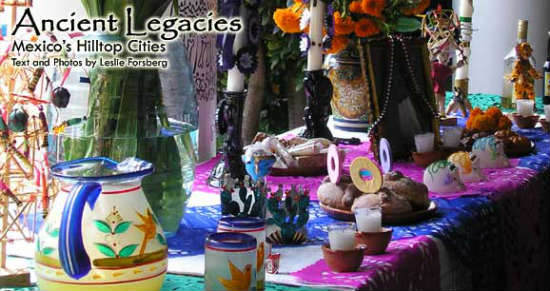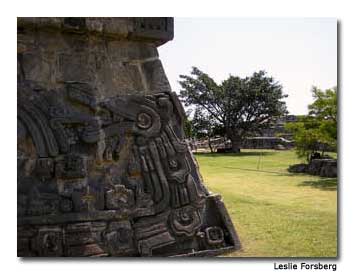

As we drove our rental car into the parking lot outside Mexico’s Xochicalco archaeological site, an immense white butterfly, the size of my husband’s large hands, hovered overhead. The luminous creature seemed to guide us toward the stone steps leading to the ruins. The splendor of this elegant emissary and its unexpectedness seemed to symbolize our exploration of Mexican culture — past and present — in the foothills of the Sierra Madre mountains, south of Mexico City.
My husband, Eric, and I clambered up the steep stair-steps of a pyramid, aiming for the summit. Yet, as with scrambling up a mountainside, once we arrived there, we found that it wasn’t the true summit: At the far end of the high, parade ground–like terrace we stood on was yet another pyramid, soaring even higher into the sky.
“It’s a pyramid atop a pyramid!” pronounced Eric.
Stone viewing seats edged the sides of the field, with more seating seemingly available on the steps of the rear pyramid. I imagined a magnificently garbed Toltec king and his entourage watching a competitive ball game from their royal “box seats.”
We crossed the greensward, and then stepped up the tall stone blocks of the smaller pyramid at the back of the field, which seemed to brush the sky’s vast blue dome. Large blue morning glories tangled in treetops twined up the sides of the structure. The high mountain air was still and humid, and I brushed a strand of hair off my sticky neck.
Trudging slowly upward, we passed what appeared to be guards’ quarters, before emerging at the top. Up here, where they could catch any stray breezes, and seemingly miles above any enemies, was where the royalty lived.
Walkways leading off in various directions led to a catacomb of small stone rooms; those with stone benches at one end were obviously sleeping quarters. I could imagine the numerous royal children lingering near the cooking quarters in the center, which featured doorways going off in opposite directions to tiny patios.
When we reached the far end of the rooms, I peered over a stone wall and gasped. It was a sheer drop of hundreds of feet to a forest of pine and oak, shielding the occupants from any enemies that might attempt to attack this stronghold. The view of undulating forest canopy was broad, perhaps 20 miles (32 km) distant, to a set of rolling hills.
As we headed back down, one of the stone rooms was different from the others. Seen from above, it resembled a regular oblong-shaped room, yet the entrance was a tunnel just big enough to wriggle through. The mystery tugged at me until I crouched down and belly-crawled through the opening. Inside it was unremarkable, except for its high walls with no door. A storage room for grain? A child’s room? An isolation room for punishment? Who knows?
The ruins hold many mysteries yet to solve. Yet what is known is that Xochicalco (meaning “in the place of the house of flowers” in the Nahuatl language, which is still spoken throughout Mexico) was occupied beginning around 200 B.C., and it reached its apex architecturally between A.D. 700 and 1000, after the fall of Teotihuacán, near Mexico city. Some speculate that this kingdom of some 20,000 residents may even have participated in the downfall of Teotihuacán.
In fact, one of the pyramids here holds the same carved deity as one found at Teotihuacán, a reminder of the influence the two sites had on each other: The intricately carved, undulating serpent on the Temple of Quetzalcóatl (which means feathered serpent), a major deity of ancient Mexico, is an exquisite piece of art. Between the arched curves of the serpent’s body are carved portraits of individuals, assumed to be the rulers who founded Xochicalco.
Carved stelae lay on the grass in one plaza, toppled by time and the elements. We attempted to decipher the faint patterns worn nearly smooth by the relentless sun and dry, high-mountain winds. Numerous stone outer buildings spread out on terraces at the foot of the ceremonial pyramid, from palaces to yet more step-style pyramids, from ball courts to a circular set of altars, and even an underground observatory.
Much of the artwork found at the site is now kept in the nearby Xochicalco Museum, a gem of a building built a decade ago, that is kept at the right temperature and humidity through natural means, employing the constant wind and water cisterns.
The museum’s collection ranges from elaborately designed vessels and figurines to impressive stone stelae. In one display case, a delicate, two-inch (5 cm) carved stone duck would be beloved by any child of today, and a whimsical clay pot made me laugh: A frog’s front legs and head gripped the vessel’s neck, its legs protruded out the back of the vessel.
Art was on our minds as we drove the winding road down the mountainside and headed southwest to Taxco, a colonial town about 10 miles (16 km) to the southwest. Once known for its silver mining, today Taxco is Mexico’s center for traditional silverwork.
The popularity of Taxco, which clings to a steep slope of the Sierra Madres, became apparent the moment we rounded the last high-mountain bend and rolled over the village cobblestones. Young men in white shirts competed to get us to park in nearby pay lots. Our “handler” proffered a free map of the town with specific jewelry shops marked. And we were off on a quest to find me that perfect necklace.

Small, whitewashed jewelry galleries with red tile roofs jostled side by side in rows on either side of the narrow street like teeth in a smile, arching across the hillside. Eric and I divided up the shops by choosing sides of the street. We laced in and out of shops, surveying the wares, and then catching each others’ eyes and shaking our heads.
Some shops carried inexpensive, lightweight silver pendants and chains, while others carried more substantial pieces ranging from heavy silver bracelets with pre-Columbian symbols such as birds, snakes and fish, to modern geometric designs on necklaces, rings and earrings.
The farther we went, the narrower the street seemed to grow, and the more congested the foot and car traffic. As we drew closer to the center of the town, the dome of the beautiful baroque Santa Prisca Cathedral, the city’s pride and joy, towered above. Then, after an hour of hunting, we found it: A stunning, multi-strand necklace of tubular silver beads that cascaded like water rushing around a river bed, from one shoulder to the other. Success!
One glance at Eric, with his bemused smile and weary expression, and I realized that I had found it just in time before the search was called off.
Flush with excitement over my find, we drove 50 miles (80 km) back to Cuernavaca, the burgeoning capital of the state of Morelos, with more than one million residents. We had arrived the night before in this colorful colonial city that’s known as “the City of Eternal Spring.”
This lush, tropical place has emitted a siren call to vacationers for hundreds of years. Everyone from Aztec kings to the conquistadors to the rich and famous have made Cuernavaca their bit of vacation paradise.
The next morning, our first stop was the Palacio de Cortés. Built for conquistador Hernán Cortés in the 16th century, it houses a regional history museum today. Here, we admired master artist Diego Rivera’s monumental mural, commissioned in 1929, that depicted historical themes such as the Spanish conquest of Mexico, in bold colors and a strident fashion.
We wandered past numerous fountains and a duck pond with rowboats for rent in the city’s formal garden, Jardín Borda. And we visited the magnificent Cuernavaca Cathedral, where we marveled over frescoes uncovered in the 1960s that depicted the martyrdom of San Felipe de Jesús in, of all places, Japan.
As dusk fell, we followed the sounds of big-band music in the city’s main square, the Zócalo, a few blocks from our hotel. We were greeted with the ages-old sight of a Saturday night in Latin America: Families dressed in their best strolled across the plaza, young girls in chiffon-skirted dresses dragged dads toward trinket vendors, and young boys played hide-and-seek. Onlookers sat on stone benches surrounding the square, visiting as they watched others parade past.
As the band packed up, a new sound began: The rattle of hundreds of shells on ankle bracelets, worn by a troupe of young men and women striding proudly into the plaza. All was silent as they took up their positions. Then, with a rattle that sounded like a dry wind racing over hilltop grasses, they began stomping and dancing to ancient ancestral rhythms, rhythms that can still be seen and felt in this mountainous region of central Mexico.
If You Go
A visit to Xochicalco and Taxco makes an ideal day trip from Cuernavaca, which is situated on Highway 95, 55 miles (89 km) southwest of Mexico City. Xochicalco is 26 miles (42 km) southwest of Cuernavaca, and Taxco is another 24 miles (39 km) farther southwest.
Xochicalco Tourism
www.surf-mexico.com
Mexico Tourism Board
www.visitmexico.com
- Life of a Champion: Exploring the Muhammad Ali Center in Louisville - April 19, 2024
- What It’s Like to Live as an Expat: Lake Chapala, Mexico - April 18, 2024
- Top 5 Spots for Stargazing in North Carolina - April 17, 2024
